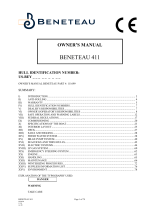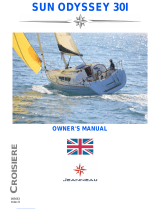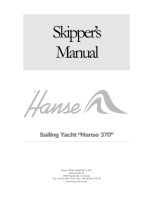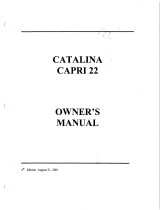Page is loading ...

FIRST 21.7
ANG 24/06/04
OWNER’S MANUAL
FIRST 21.7
FR-BEY _ _ _ _ _ _ _ _ _
BENETEAU REF : ./
SUMMARY:
I) INTRODUCTION................................................................................................................................................3
II) IDENTITY CARD OF THE BOAT ...................................................................................................................4
III) ACCOMMODATION.......................................................................................................................................6
IV) DECK (Location of the life raft) .......................................................................................................................8
V) SAILS AND RIGGING......................................................................................................................................9
VI) FRESH WATER SYSTEM.............................................................................................................................12
VII)BILGE PUMP SYSTEM ................................................................................................................................14
VIII) SEACOCKS AND SKIN FITTINGS...........................................................................................................16
IX) ELECTRIC SYSTEMS ...................................................................................................................................17
X) GAS SYSTEM..................................................................................................................................................20
XI) EMERGENCY SYSTEM OF THE STEERING SYSTEM...........................................................................22
XII) MOTORIZATION .........................................................................................................................................23
XIII) HANDLING .................................................................................................................................................25
XIV) MAINTENANCE.........................................................................................................................................26
XV) ENVIRONMENT ..........................................................................................................................................29
XVI) CENTREBOARD SYSTEM ...................................................................................................................... 30
EXPLANATION OF THE TYPOGRAPHY USED:
DANGER
WARNING
TAKE CARE

FIRST 21.7
ANG24/06/04 2 / 30
RECEIPT
OWNER’S NAME …………………………………………………………………………..
ADDRESS …………………………………………………………………………..
…………………………………………………………………………..
…………………………………………………………………………..
Owner of the FIRST 21.7 n° ……………………………………………………………………………….
Do certify that I have accepted delivery and read the information in the owner’s manual delivered with the boat.
On …………………………………………
Signature
Please keep this copy for your records
•••••••••••••••••••••••••••••••••••••••••••••••••••••••••••••••••••••••••••••••••••••••••••••••••••
RECEIPT
OWNER’S NAME : …………………………………………………………………………..
ADDRESS : …………………………………………………………………………..
…………………………………………………………………………..
…………………………………………………………………………..
Owner of the FIRST 21.7 n° ……………………………………………………………………………….
Do certify that I have taken delivery and read the information in the owner’s manual delivered with the boat.
On …………………………………………
Signature
Please send back this copy to CHANTIERS BENETEAU S.A
ZI des Mares BP66
85270 Saint Hilaire de Riez
FRANCE

FIRST 21.7
ANG24/06/04 3 / 30
I) INTRODUCTION
Dear Madam, Dear Sir,
You have just taken delivery of your new BENETEAU boat and we would like to congratulate you first of
all for the confidence you showed to us in choosing a product of our mark.
A BENETEAU boat is built to last : each boat is subject to particular care in the slightest details, as early as
when she is designed, when she leaves the factory and she is launched ; this way, she will come up to your
expectations for many years.
This manual was meant to help you to enjoy your boat safely. You will find in it the details of your boat ,
her fittings and information about the use and maintenance. Read it carefully and get to know her before you put out
to sea.
If this is your first boat, or if you change to a new type of boat (to which you are not used) get some training
to control and sail her , to ensure your safety and comfort. Then you will be able to assume the command of the boat.
Your dealer, your national sailing association or your Yacht club will be very happy to recommend you local sailing
schools or professional instructors.
Have fine and safe sailing time.
(1) Throughout their lives, our boats are regularly improved and benefit from our experience and our
customers’ experience ; therefore the specifications given in this owner’s manual are not contractual and may be
modified without prior notice and up dating obligation.
In the same way, this manual has a general purpose and it may sometimes list some equipments or refer to
some points which are not relevant to your own boat. In case of doubt, you shall always refer to the inventory list.
KEEP THIS MANUAL IN A SAFE PLACE AND HAND IT OVER TO THE NEW OWNER IF YOU SELL THE
BOAT.

FIRST 21.7
ANG24/06/04 4 / 30
II) IDENTITY CARD OF THE BOAT
Type ....................................................... FIRST 21.7
Name of Builder .................................... CHANTIERS BENETEAU SA
Design Category..................................... B
N° of acknowledged body...................... CE 0607
Length of Hull 6.25 m
Over All Beam 2.48 m
Draught: Shallow :
Deep:
0.70
1.80
m
m
Clearance Height 10.40 m
Maximum Authorized Engine Power : 8 kW
Fresh Water Capacity 35 Litres
Battery Capacity 45 Amp
Category Height of Waves
(m)
Wind Force
(Beaufort)
A > 4 > 8
B < 4 < 8
C < 2 < 6
D < 0.5 < 4
For additional information concerning the fitted equipment, please refer to their manuals enclosed in the boat
litterature.
Maximum recommended number of persons on board by design category:
Category Number of
persons
A
B 4
C 6
D 6
The equipments of the C.E. Certified boat are : The fuel tanks, the parts of the steering system, the parts of the gas
system and the hatches and portholes.
(1)

FIRST 21.7
ANG24/06/04 5 / 30
WEIGHT ESTIMATION
SAILING CATEGORIES A B C D
Light Boat : 1185 1185 1185
Safety Equipment : 45 45 45
Sail : 15 15 15
Light Displacement : 1245 1245 1245
Minimum Crew : 75 75 75
Life Raft : 30 30 30
Rest of Crew : 225 225 225
Personal Equipment: 125 125 125
Optional Equipment (6 HP Outboard Engine) 40 40 40
Margin for Extra Equipment : 45 45 45
MAXIMUM LOAD DISPLACEMENT
(Kg)
1785 1785 1785
MAXIMUM LOAD (Kg) 540 540 540
MAXIMUM LOAD = MAXIMUM LOAD DISPLACEMENT – LIGHT DISPLACEMENT
ANY OVERLOADING CARRIES A RISK OF FLOODING OR LOSS OF STABILITY

FIRST 21.7
ANG24/06/04 6 / 30
III) ACCOMMODATION

FIRST 21.7
ANG24/06/04 7 / 30
EXIT IN CASE OF FIRE
= Recommended Exit

FIRST 21.7
ANG24/06/04 8 / 30
IV) DECK
- The safe lines can be fastened either on the mooring cleats or on the toe rail.
Some boats are fitted with a foldaway swimming ladder. The swimming ladder shall be in its usual
place on the transom as soon as you are on board.
Make sure that the hatches and portholes are closed before you put out to sea.
In case of rough sea, close the boat with her door and washboard so that no water may come into the
boat
Check that nothing blocks up the draining holes ; never seal them.
1 Location of the life-raft

FIRST 21.7
ANG24/06/04 9 / 30
V) SAILS AND RIGGING
Specifications of the Sails :
SAIL AREA m²
I 8.59 m
Total 25.20 m² J 2.40 m
Main Sail 13.80 m² P 8.24 m
Genoa (maxi) 11.40 m² E 2.85 m
Spinnaker 34.70 m² LP 2.67 m
Specifications of the Standing Rigging:
V : Vertical - D : Diagonal
REF CABLE Ø mm
1 V1 (Shroud) 4
2 D1 (Lower Shroud ) 4
3 Forestay 4
4 Preventer Backstay 3

FIRST 21.7
ANG24/06/04 10 / 30
DECK FITTING LAY OUT
REF STANDARD MAST
1 Genoa Furling Line
2 Mainsail Halyard
3 Reef n° 1
4 Spinnaker Boom Toppping Lift
5 Reef n° 2
6 Spinnaker Halyard
7 Spinnaker Boom Downhaul

FIRST 21.7
ANG24/06/04 11 / 30
MAINSAIL TACKLE

FIRST 21.7
ANG24/06/04 12 / 30
VI) FRESH WATER SYSTEM (OPTIONAL)
REF DESCRIPTION
1 Water Tank 35 l
2 Hand Pump – Fresh Water
4 Filler – Fresh Water Tank
13 Galley Sink
The fresh water system supplies the sink in the galley and the washbasins. This supply is made depending on
the models, either by a manual pump , or by an electric pump; before this pump there is a filter it is necessary to clean
regularly.
Never run an electric pump when the tank is empty otherwise it might be irreparably damaged.
Never force the filling nozzle deep down the filler pipe in order to prevent any over pressure in the systems
and keep an eye on the vent hole(s) through which the water in excess will be discharged.
When the system has not been used for a long period of time, the tanks and pipes shall be cleansed with an
acetic acid solution (white vinegar)
The water flows out from the sink and wash basins through their own skin fitting seacocks ; Close them when the
water system is not used.

FIRST 21.7
ANG24/06/04 13 / 30
LAY OUT OF THE FRESH WATER SYSTEM

FIRST 21.7
ANG24/06/04 14 / 30
VII) BILGE PUMP SYSTEM
REF DESCRIPTION
1 Inside Manual Bilge Pump 0.75 l/mn
2 Outside Manual Bilge Pump 1.9 l/each time
3 Inside Bilge Pump Intake
4 Outside Bilge Pump Intake
5 Inside Bilge Pump Delivery
6 Outside Bilge Pump Delivery
Make sure the bilge pump system is in good working order before you put out to sea.
Make yourself acquainted with the way the bilge pump system of your boat works :
- Locate the manual bilge pump and the handle which enables you to make it work.
- Locate the on switch of the electric bilge pump and get to know how the seacocks work (for
the boats fitted with an electric bilge pump).
(See the lay out drawing of the system in the owner’s handbook)
Make sure that the bilge pump intake strum box is not blocked with dirts.
Regularly clean the intake strum box on the sump and the filter of the system in case of an electric pump.

FIRST 21.7
ANG24/06/04 15 / 30
LAY OUT OF THE BILGE PUMP SYSTEM

FIRST 21.7
ANG24/06/04 16 / 30
VIII) SEACOCKS AND SKIN FITTINGS
Close all the seacocks when you leave the boat.
The flushing toilets may be situated below the waterline ; get into the habit of systematically closing
the seacocks after each use.
Make sure that all the seacocks which are not used are closed before you put out to sea. (in the owner’s
manual, see the drawing where the lay out of the skin fittings is shown).
Opening and closing of the seacocks
Open
Closed
REF DESCRIPTION
1 Washbasin Outlet
SEACOCK AND SKIN FITTING LAY OUT

FIRST 21.7
ANG24/06/04 17 / 30
IX) ELECTRIC SYSTEMS
When the voltage is not specified, all the functions or panels are in 12 Volts.
12V Electric System
Never work on a live electric fitting.
Never tamper with an electric fitting. Call in a technician qualified in marine electricity.
The batteries must be carefully and safely stowed.
In order to prevent a short circuit between the battery terminals, do not store conductive objects near the
batteries (e.g. metal tools, ...)
Never alter the specifications of the devices which protect against overstrength.
Never fit or replace the electric materials or appliances by components which exceed the system amperage.
110V-220V Electric System
Some boats are fitted with a 110V or a 220 V system (some as standard, others as an option, depending on
the models). We advise you to follow the below mentioned steps in order to avoid the risks of electric shocks and of
fire.
Do not work on a live fitting.
Connect the boat / shore supply cable in the boat before you plug it into the shore supply socket itself.
Do not immerse the boat / shore cable sockets.
Switch off the shore supply with the switch on board before you plug in or unplug the boat / shore supply
cable.
Do not tamper with the connections of the Boat / shore supply cable. Use only compatible connections.

FIRST 21.7
ANG24/06/04 18 / 30
ELECTRICITY LAY OUT
2 Function Panel
6 Function Panel (OPTIONAL) :

FIRST 21.7
ANG24/06/04 19 / 30
LAY OUT OF THE 12V LIGHTS AND APPLIANCES
On the 2 function panel :
REF DESCRIPTION N°
1 Mast Head Light 1
2 Inside Light 2
On the 6 function panel :
REF DESCRIPTION N°
A Navigation Lights 1
B Mooring Light
C Navigation
D Inside Light 2
E Bilge Pump
F Spare
12V LIGHT AND APPLIANCE LAY OUT

FIRST 21.7
ANG24/06/04 20 / 30
X) GAS SYSTEM
Gas Stove
The boat is delivered without any fire extinguisher. It is your own responsibility to comply with the
laws and regulations of your own country (Number, capacity, type and place of fire extinguishers).
We advise you at least to install an extinguisher less than 5 metres away from each berth, less than 2 meters
away from the extinguisher aperture in the engine compartment, less than 2 meters away from any naked
flame device and less than 1 meter avay from the helm pedestal. We advise a total capacity of the portable
extinguishers reaching 8A/64B, each extinguisher having at least a 5A/34B capacity. The CO2 extinguishers
shall be used to fight fires in the galley or electric fires.
Do not fit or store flammable materials above or over the stove (Curtains, papers, napkins,
and so on……).
Never leave the boat unattended when the gas or spirit appliances are working.
The appliances which use fuel consume the oxygen within the cabin and release the combustion
products into the boat. It is necessary to ventilate the boat when the gas cooking appliances are working. Do
not obstruct the air vents of the boat.
Do not smoke or use a naked flame when you are trying to locate a gas leak or when you change the
gas bottle or whenever you intervene on the gas system.
If you smell gas or find that the burners have gone out, by accident, (although appliance models cut off
the gas automatically if the flames go out) turn off the gas taps and do ventilate the boat in order to get rid of
any residual gas. Find the root of the problem.
For the stoves with an integral gas cylinder you shall change the cylinder outside the boat. Test the
stove before you put it back in the galley. Pay particular attention to the stove fittings and make sure the stoves
are locked after they have been put in their places.
Do not use cooking appliances to heat the inside of the boat.
Make sure that the taps of the burners are turned off before you turn on the tap of the hoses and of
the cylinder.
Turn off the tap on the feed hose and the taps on the cylinders when you do not use the appliances.
Do not obstruct the access to the gas system components, in particular the access to the taps (cylinders and
gas cooker).
The flexible hoses which connect the gas cylinder at one end of the system and the stove at the other end,
shall be changed in pursuance of the regulations in force in your country. Only use hoses which meet the safety
standards of your country.
Do not use the gas cylinder storage space to store other equipments.
Pay particular attention to keep in good condition the screw thread of the cylinder on which the regulator is.
Check the condition of the regulator every year and change it if necessary. Use a regulator identical to the ones which
are fitted.
Make sure that the taps of the empty cylinders are turned off and disconnected from the system.
Do not use ammonia based products to clean it or to discover a leak.
/













